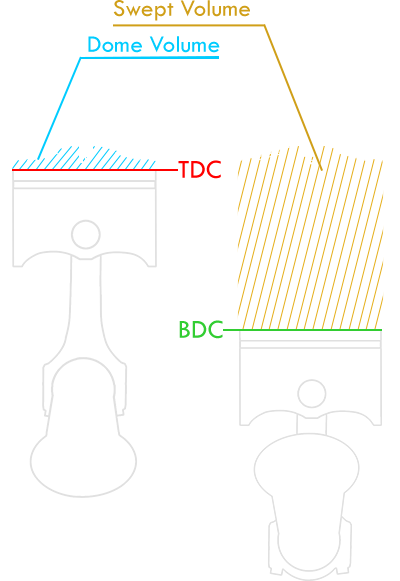The Squeeze: Demystifying Static Compression Ratio
The Static Compression Ratio (SCR) is a fundamental, purely mechanical measurement of an engine. It represents how much the air-fuel mixture is squeezed on the compression stroke. This single ratio is one of the most significant factors influencing an engine's thermal efficiency, power output, and fuel requirements.
The Anatomy of the Ratio
SCR is the ratio of the total volume in the cylinder at Bottom Dead Center (BDC) to the volume at Top Dead Center (TDC).
Calculating Total Clearance Volume
First, we sum all the small volumes remaining when the piston is at TDC. This is the "squeezed" volume.
The Final Ratio
The final ratio compares the total volume (swept + clearance) to the clearance volume alone.
The Compression Trade-Off: Power vs. Practicality
High Compression (e.g., 11:1+)
Extracts more energy from the fuel, leading to higher thermal efficiency, better throttle response, and more power. It's the standard for naturally aspirated performance engines but requires high-octane fuel to prevent knock.
Lower Compression (e.g., 8:1 - 10:1)
Creates more "room" in the cylinder, making it essential for forced induction (turbo/supercharger) to accommodate the pressurized air without dangerous pressure spikes. It is also more tolerant of lower-octane fuel.
The Knock Limit: The Enemy of Compression
The primary limitation to raising compression is detonation, or "engine knock."
- What is Detonation?
- It's a violent, uncontrolled explosion of the air-fuel mixture, rather than a smooth burn. This creates a destructive shockwave inside the cylinder, which can damage pistons, rings, and bearings. High compression increases heat and pressure, making detonation more likely.
- The Role of Octane
- A fuel's octane rating is a measure of its resistance to detonation. Higher octane fuels (e.g., 91, 93, E85) allow for higher compression ratios without knocking, which is why performance engines demand premium fuel.

